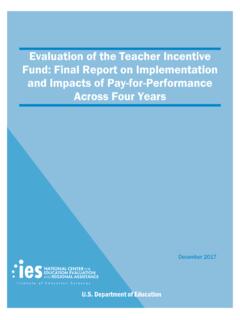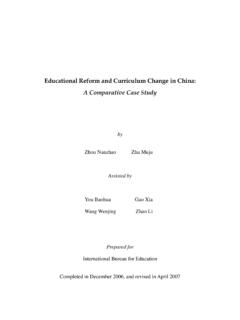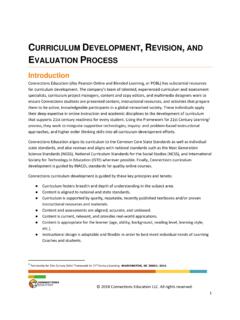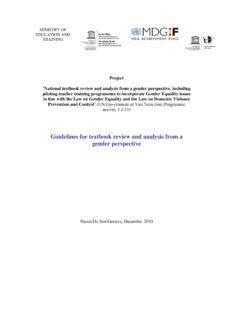Transcription of Which math curriculum should I use?
1 NCEE EVALUATION BRIEF September 2013 AFTER TWO YEARS, THREE ELEMENTARY math CURRICULA OUTPERFORM A FOURTH Which math curriculum should I use? This brief aims to help educators understand the implications of math curriculum choice in the early elementary grades by presenting new findings from a study that examined how four math curricula affect students achievement across two years from 1st through 2nd The four curricula were (1) Investigations in Number, Data, and Space (Investigations); (2) math Expressions; (3) Saxon math (Saxon); and (4) Scott Foresman-Addison Wesley Mathematics (SFAW), Which the developer revised and renamed enVision math (enVision) during the study.
2 These curricula are widely used and differ in their approaches to teaching and learning. Within districts, we randomly assigned one of the four curricula to each school that participated in the study. After one year (by the end of 1st grade), students taught with math Expressions and Saxon made greater gains in achievement than students taught with Investigations and SFAW. After two years (by the end of 2nd grade), Investigations students continued to lag behind math Expressions and Saxon students, while SFAW/enVision students caught up to math Expressions and Saxon students. Therefore, math Expressions, Saxon, and SFAW/enVision improved 1st-through-2nd-grade math achievement by similar amounts, and all three outperformed Investigations.
3 Our findings also suggest that switching between some of the study s curricula does not harm student achievement and can even be beneficial. 2 AFTER TWO YEARS, THREE ELEMENTARY math CURRICULA OUTPERFORM A FOURTH NCEE EVALUATION BRIEF The selection of a math curriculum affects the nature of mathematics instruction and, ultimately, the opportunities for students to learn mathematics. According to the national Research Council (2001), Opportunity to learn is widely considered the single most important predictor of student achievement. Research confirms this important connection between curricula and achievement. For example, at the elementary level, previous findings issued by this study indicate that some curricula improve the average student s percentile rank in math by as much as 12 points more than other curricula during the first year of implementation (Agodini et al.)
4 2009, 2010). The choice of curriculum is particularly critical for elementary schools because they tend to use one math curriculum in several grades, thus affecting students for multiple years. However, little is known about how these curricula affect students over time. This is a key issue because curricula differ in important ways that could have implications for students learning over time and, therefore, their effects may differ from those found after a single year. For example, differences between curricula in the sequencing of concepts, the extent of review of previously learned skills, or the alignment with student assessments in different grades could lead to achievement effects that vary from year to year.
5 Also, some curricula place higher cognitive demands on students, by having them figure out important mathematical ideas that typically are not immediately apparent. This practice helps students develop conceptual understanding of math that could improve gradually over several years (Hiebert and Grouws 2007). Finally, some curricula are clearer about the objectives of the lessons and provide better teacher supports for implementing the lessons (Stein and Kaufman 2010), Which could in turn lead to differing effects across years and grades. To help educators more fully understand this issue, we expand on previous findings from this study by examining how four math curricula affect students achievement across two years from 1st through 2nd grades: (1) Investigations in Number, Data, and Space (Investigations); (2) math Expressions; (3) Saxon math (Saxon); and (4) Scott Foresman-Addison Wesley Mathematics (SFAW), Which the developer revised and renamed enVision math (enVision) during the These curricula are widely used in the early elementary grades3 and, as described below, differ in their approaches to mathematics instruction.
6 When making curricular decisions, it is important to consider not only the potential effects of the new curriculum , but also the implications of switching from one curriculum to another. Because many districts make their own curricular decisions, and some districts let schools choose their own curriculum , students who move from one district or school to another could switch curricula. This issue is of particular concern for disadvantaged students, who are more likely to transfer between schools (Rumberger 2003). Switching curricula also could be an issue for students who do not transfer between schools because many districts review their elementary math curriculum every several years and often adopt a new one at that time, resulting in a large fraction of students experiencing more than one math curriculum during their elementary For example, California, Florida, and Texas are among 22 states with a textbook adoption process that every six years or so determines a selection of math texts that districts can purchase with state funds.
7 And districts in these states tend to follow this curriculum adoption Our study also provides evidence that helps educators understand the effects on student achievement of switching from one curriculum to another. AFTER TWO YEARS, THREE ELEMENTARY math CURRICULA OUTPERFORM A FOURTH 3 NCEE 2013-4019 This brief addresses three questions: 1. Do some of the study s curricula improve 1st-through-2nd-grade student math achievement more than others? 2. How do these curriculum -group differences in achievement after two years (by the end of 2nd grade) compare with the curriculum -group differences after one year (by the end of 1st grade)? 3. How does switching curricula (instead of staying with the same one) affect student achievement during the first year a new curriculum is used?
8 In the remainder of this brief, we provide an overview of the study design, including the selection, description, and assignment of study curricula. Next, we examine curriculum implementation to place the student achievement effects in context. We then present our findings on the achievement effects of elementary math curricula after one and two years, along with the effects of switching curricula. Finally, we conclude with a discussion and suggestions for future research. Study Design To set up the study, we (1) selected the curricula to be included, (2) documented the key ways in Which the programs differ, and (3) randomly assigned the curricula to schools that agreed to participate in the study.
9 Selecting the Curricula We used a competitive process to choose our curricula. Developers and publishers of math curricula for early elementary school were invited to submit proposals to have their curricula included in the evaluation. The goal of this process was to select curricula that represented varied approaches to instruction and learning and were likely to improve student achievement more than other curricula. To meet this objective, we used six criteria to review the submissions: (1) research support for the curriculum s conceptual framework, (2) empirical evidence of effectiveness, (3) teacher practices and skills that comprise the curriculum , (4) quality of training and materials, (5) institutional capacity to train the number of teachers in the study, and (6) appropriateness of the curriculum for early elementary students in Title I schools.
10 An independent panel of experts in math and math instruction reviewed the submissions and recommended curricula they believed were suitable for the study. In-person meetings were held with publishers whose curricula were considered strong candidates, after Which IES selected the four curricula mentioned Important Differences Between the Curricula To summarize the differences between the curricula, we conducted a comparative analysis that was framed using research on effective mathematics instruction. This research has found that three aspects of curricula are likely to have a strong influence on instruction (that could affect student achievement): (1) mathematical emphasis, (2) instructional approach, and (3) supports for For each aspect, our review of curriculum materials revealed substantial variation across the four curricula, as expected.


















